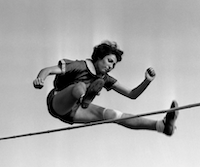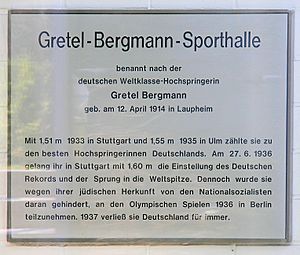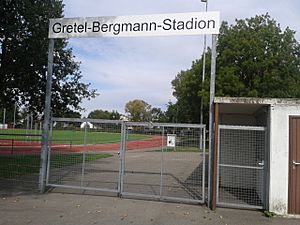Gretel Bergmann facts for kids
 |
|
| Personal information | |
|---|---|
| Birth name | Margarethe Bergmann |
| Full name | Margaret Bergmann-Lambert |
| Ethnicity | German Jewish |
| Citizenship | German American |
| Born | April 12, 1914 Laupheim, Württemberg, Germany |
| Died | July 25, 2017 (aged 103) Queens, New York, U.S. |
| Residence | Queens, New York, U.S. (1937–2017; longest place of permanent residence) |
| Occupation | Athlete |
| Years active | 1930–1939 overall; 1930–1933 and 1936 in Germany, 1934 in the United Kingdom, 1937–1939 in the United States |
| Spouse(s) | Bruno Lambert, M.D. |
| Sport | |
| Country | Germany, excluded due to ethnicity in 1933 and 1936 United States |
| Sport | Track and field |
| Event(s) | High jump |
| Retired | Forced to retire in 1936 by Germany Retired in the United States in 1939 |
| Updated on 26 July 2017. | |
Gretel Lambert, born Margarethe Bergmann (April 12, 1914 – July 25, 2017), was a talented German-Jewish track and field athlete. She was especially good at the high jump during the 1930s.
Because she was Jewish, the Nazis stopped her from competing in the 1936 Summer Olympics. After this, she left Germany and promised not to return. However, she did visit Germany in 2004 to meet her old friend and rival, Elfriede Kaun. Gretel Bergmann lived to be 100 years old in 2014. She passed away in 2017 at her home in Jamaica Estates, Queens, New York.
Contents
Early Life and Athletic Start
Margarethe Bergmann was born in 1914 in Laupheim, Germany. Her father, Edwin Bergmann, was a businessman.
She started her sports career in Laupheim. In 1930, she joined a sports club called Ulmer FV 1894. She won her first high jump title in 1931 at the South German Championships, jumping 1.51 meters. She won this title again in 1932.
Facing Challenges in Germany
After the Nazis came to power in 1933, Gretel was forced to leave her sports club because she was Jewish. In April of that year, her parents sent her to the United Kingdom for safety.
In 1934, she competed in the British Championships. She won the high jump there with a height of 1.55 meters.
The Olympic Dream and Nazi Interference
The German government wanted Gretel to come back to Germany. They wanted to show the world that their Olympic team choices were fair, even though they were treating Jewish people badly. They even threatened her family if she did not return.
Gretel agreed and went back to Germany. She was allowed to train for the 1936 Olympic Games. In 1935, she won the high jump in the Württemberg Championships. On June 30, 1936, just a month before the Olympics, she tied the German record by jumping 1.60 meters.
Banned from the Berlin Olympics
Even though Gretel Bergmann-Lambert had matched the high-jump record and had been on the team for two years, she was banned from the Berlin Olympics. Two weeks before the games, German sports officials sent her a letter. It said she was removed from the team for not performing well enough.
She was not replaced by another athlete. Germany only had two high jumpers: Dora Ratjen and Elfriede Kaun. A few weeks later, Gretel's record-tying jump was removed from the official records.
Life in the United States
In 1937, Gretel moved to the United States. She settled in New York City and married Bruno Lambert, who was a physician.
That same year, she won the U.S. women's high jump and shot put championships. In 1938, she won the high jump again. Her sports career ended when the United States joined World War II. In 1942, she became a citizen of the United States.
Awards and Recognition

Gretel Bergmann's story became well-known again in 1980. This was when she was added to the Jewish Hall of Fame in Wingate Institute in Israel.
In August 1995, a sports complex in Berlin-Wilmersdorf was named after her. Gretel had said she would never return to Germany, so she did not attend the ceremony. In 1996, she was inducted into the National Jewish Sports Hall of Fame in the United States. In 1999, she received an award called the Georg von Opel-Preis for her achievements in sports and society.
The stadium in Laupheim, where she had been banned from competing in the 1930s, was also named after her in 1999. Gretel later said that she understood that the people now were not responsible for what happened in the past.
In 2004, a documentary about her life in Germany, called Hitler's Pawn – The Margaret Lambert Story, was shown on HBO. This happened before the 2004 Summer Olympics.
On November 23, 2009, her German national record of 1.60 meters from 1936 was officially put back into the records by the German track and field association. They also asked for her to be added to the German sports hall of fame. In September 2009, a film called Berlin 36 was released in German theaters. It was about her training for and being excluded from the 1936 Olympics.
Honors
In August 2014, a street in the Olympic Park Berlin was renamed "Gretel-Bergmann-Weg" in her honor.
See also
 In Spanish: Gretel Bergmann para niños
In Spanish: Gretel Bergmann para niños
- 1936 Summer Olympics
- List of Jewish American sportspeople
- List of Jews in sports
- History of the Jews in Laupheim
- List of centenarians (sportspeople)
In film
- Die Angst sprang mit — Die jüdische Hochspringerin Gretel Bergmann (SWR, 2004 (TV documentary), Inhaltsangabe)
- Hitler's Pawn — The Margaret Lambert Story. imdb.com; accessed September 10, 2017.
- Berlin 36 — Die wahre Geschichte einer Siegerin. (Germany 2009), directed by Kaspar Heidelbach, Bergmann was portrayed by Karoline Herfurth
- Der Traum von Olympia — Die Nazispiele von 1936 (ARD, 2016, television docudrama, Inhaltsangabe), Bergmann was portrayed by Sandra von Ruffin.


